When it comes to choosing a rifle scope, there’s a ton of features that you need to think about. Things like magnification, bullet drop, eye relief, the objective lens, and even the type of target shooting that you’re doing. Are you going to be hunting or long range shooting? All of these are very important things to consider, but there’s one main feature that’s going to affect all of these other things as well: the rifle scope reticle.
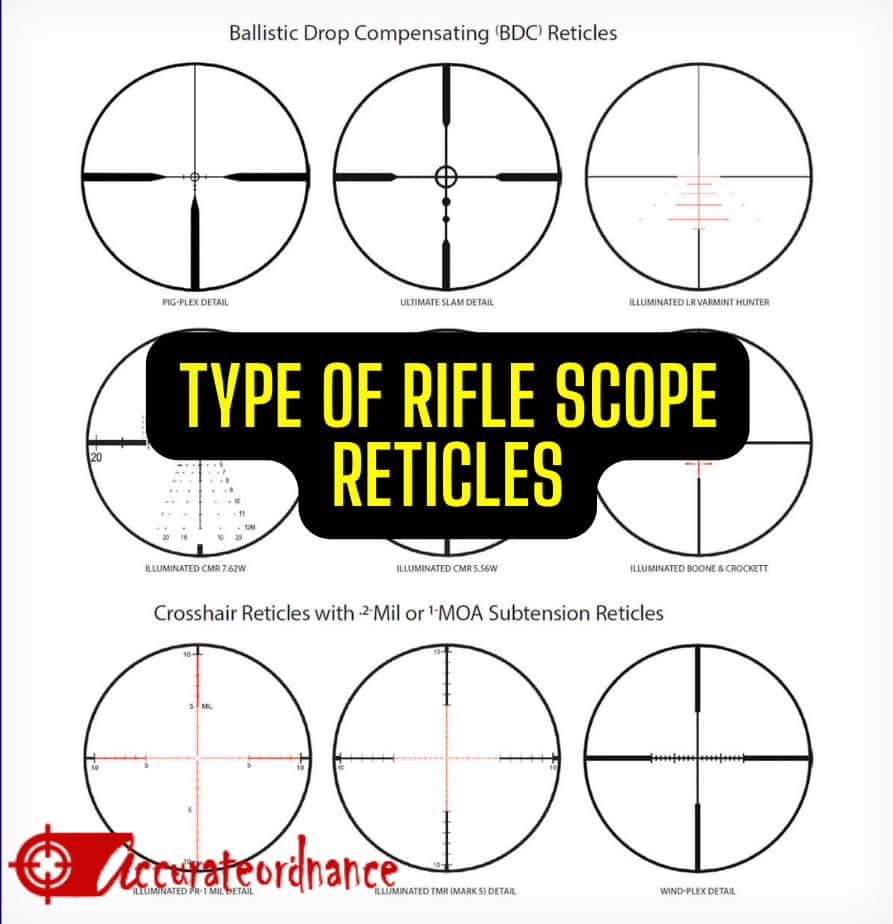
A riflescope reticle is a huge part of using a telescopic sight. There’s tons of different types of reticles, all made for different purposes like bullet drop compensation or low light condition. The aiming point is essentially what you are going to use to estimate where your shot is going to land on your target. Using a rifle scope reticle provides a great advantage over using iron sights. Reticles are much more accurate and easy to use, and can also come equipped with features like night vision, cross hairs, and even an illuminated reticle or non illuminated reticle.
While all these features are great, choosing the right ones is equally as important. You can have the most expensive scope and reticle on the market, but still have a hard time shooting if the features aren’t suited to what you need for the type of shooting that you’re doing. Today, we are going to discuss the different types of reticles that are available, what they are intended to be used for, and the benefits and drawbacks of each type. This way, you’ll be able to conduct your perfect scope search without the question of whether you’re making the right decision or not.
- Important Features to Consider
- Types of Reticles
- Understanding Reticle Types for Different Shooting Scenarios
- Reticle Adjustment and Calibration
- Reticle Materials and Construction
- Choosing the Right Scope Reticles, Factors to Consider
- FAQs
- Can I change the reticle in my scope?
- Do illuminated reticles drain the battery quickly?
- Are BDC reticles suitable for long-range shooting?
- How often should I clean my scope reticles?
- Can I use the same reticle for different shooting disciplines?
- What is the purpose of a fine crosshair reticle?
- Are mil-dot reticles difficult to learn and use?
Important Features to Consider
Let’s break down some of the most important features that come with a rifle scope reticle. Before we dive into the dot reticle or other types, let’s talk about what you should be looking for in a reticle depending on your needs.
Aiming Point
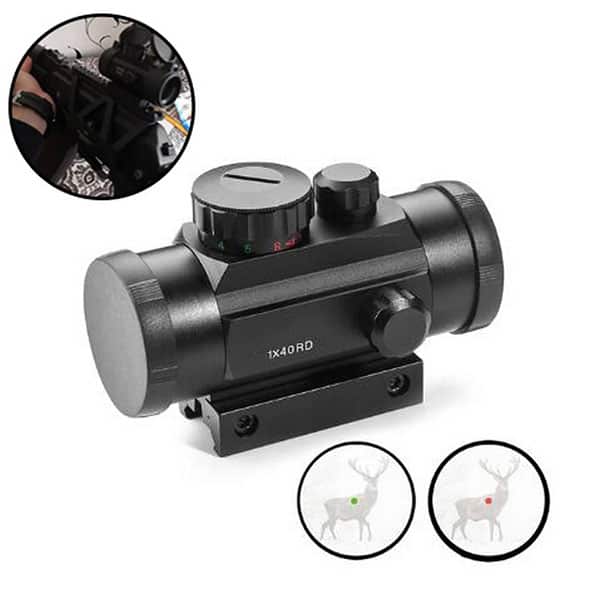
Between the different types of reticles, the aiming point is bound to look different. The aiming point is going to be at the very center of your reticle, and will be the spot that you use to estimate and aim your rifle. The aiming point can come in many different shapes. The most common ones are dots, cross hairs, triangles, or even an open circle. Some manufacturers will have their own custom, branded reticles that represent their individual company. This list of possible shapes is no where near extensive, as there’s probably hundreds of reticle shapes out there today.
What you need to think about here is how you shoot. Since the aiming point is going to be the center of your reticle and what you will rely on to make your shot, you need to make sure you get the right style that you need. When you’re looking into different cross hairs and shapes, there’s some things you should ask yourself first:
- Will it overtake your target?
- Will it block precise kill locations of the target when you use magnification?
- Do you want the reticle to remain the same size when you use magnification?
- Do you want the reticle to change size when you use magnification?
- Can you still see it on the lower magnification settings?
We’ll talk more in detail about magnification, and FFP reticle and SFP reticle later on. Just keep these key points in mind as we move forward in deciding which reticle you need.
Product Description
A great way to determine what a scope is like is to simply read the manufacturer’s product description. The product description can give you information on the scope itself, reticle style, reticle size, and other important features regarding magnification and how the reticle operates.
Often times, the reticle will be presented as either a type of cross hairs, post reticle, or a bullet drop compensation reticle, which will feature a different type of measurements. The reticle might also have other marks or lines that indicate different measurements for the scope as well as possible hold over points or a range estimation feature.
These measurements are most often going to be in yards and will depend on a specific rifle type or caliber in order for the estimates to be accurate. That’s why it’s important to read the description and make sure that the scope you are looking at is compatible and will be accurate for your specific rifle.
Especially if the scope you choose ends up being a BDC reticle, you’ll want to make sure that you understand how to use it. More than likely, a lot of the BDC scopes will require complex calculations in order to estimate the bullet drop for your rifle. So, when choosing a ballistic reticle, make sure you are ready to do some hard math on the range, or just see if the manufacturer provided a ballistics table (which would be much easier). This way, you can estimate your bullet drop but also eliminate the math work you will have to do on the spot.
Thin vs. Thick Cross Hairs
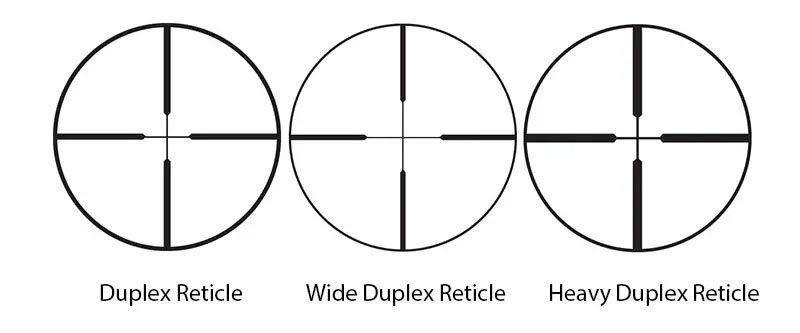
This feature can be a game changer for a shooter. Depending on your preferences and the style of shooting you’ll be doing, the thickness of your reticle lines can make a big difference on how you see your target image.
Thin
You’ll want to go for a fine crosshair if your main priority is accuracy. A fine crosshair will cover minimal surface of your target image, allowing you to precisely choose your shot and where you want to land it. A fine crosshair is probably not going to be very easy to see against a complicated background, which is something you need to consider in case you encounter that situation.
However, most fine crosshairs come with an illuminated reticle feature, which will give you great visibility of your reticle whether that’s in the day time against a tough background, or at night when it’s dark and the reticle just blends in with the shadows.
Thick
If you’re an avid hunter, than you might want to consider a thick crosshair as well. A thick crosshair is better for hunting because it provides quick and easy visibility against most targets. As soon as you look through your scope, you’ll be instantly drawn to the aiming point of the cross hairs, giving you fast target acquisition.
A thick reticle is also very easy to see against a complicated background, with minimal need for a illuminated reticle. While blocking parts of the target might be a concern with the thick posts of the reticle, most reticles typically thin out in the center, still allowing you to make decently accurate shots. You’ll also be better off when trying to locate your thick reticle in a low light condition since the posts are thicker, which can make the scope cheaper since you might not need the illuminated reticle feature.
Subtension
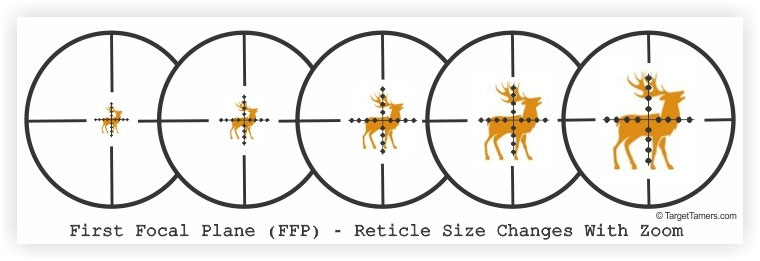
This is something that affects all scopes. Subtension is defined as the amount of surface area that your reticle is going to take up on the target image. Basically, the higher the subtension level, the more of your target that is going to be obscured by the reticle. The level of subtension is affected by the type and size of reticle as well as where the glass reticle is placed relative to the objective lens inside the scope tube.
A fine cross hair will have less subtension because it is smaller in size. While this is good for accuracy, it can be hard to see in some situations.
A thick cross hair will be greater in subtension but will be easier to see against all backgrounds. It will take up more space on your target which can lead to more room for inaccuracy.
When it comes to the topic of subtension, there’s something called focal planes. A focal plane is basically where your target lies in relation to the reticle. So, if your target is on the same focal plane as the reticle, than they will change the same way when you use magnification.
First Focal Plane
Reticles that are on the first focal plane are also known as an FFP reticle. What this means is that the glass reticle is located in front of the magnification lens. So, when you go to use your magnification, the reticle is going to change with the target. If you zoom in and the target gets bigger, so will the reticle. If you zoom out and the target gets smaller, same thing, the reticle gets smaller too.
For an FFP reticle, the level of subtension will remain constant. However, it does provide some advantages. When it comes to a BDC reticle, the FFP will allow the reticle measurements for bullet drop compensation to remain accurate with the magnification.
With that though, you take the greater chance of your reticle obscuring the target. Because the reticle will also get bigger, it will have a pretty good chance of overtaking the target you’re trying to see.
Second Focal Plane
The second focal plane reticle will be located behind the magnification lens. This means that the reticle will not change size regardless of how much you use the magnification. This means that the crosshairs won’t adjust to the target magnification, which means that the level of subtension is always going to be changing.
This can provide some benefits. For the first, you won’t have the chance of the reticle obscuring the target when you zoom in because it doesn’t change size. It can also give you increased accuracy and precision when you are aiming at long distance targets.
However, this also means that the BDC reticle feature will only be able to be used at one magnification level. Otherwise, the bullet compensation will become inaccurate if you change the magnification. It can also be difficult to see at longer ranges and higher magnification.
Types of Reticles
Now that we’ve covered what to look for in a basic scope, let’s go over the types of reticles that you have to choose from. Each offers their own benefits and drawbacks, as well as features.
Non Illuminated Reticle
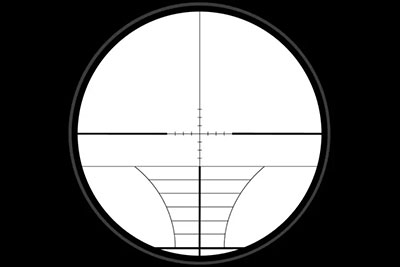
A non illuminated reticle is one that is not equipped to glow or light up in any way. While this can be great for your wallet, it might not be great if you need a versatile scope. You won’t be able to see it in low light conditions and it can be hard to detect the reticle against complicated backgrounds. But, if price is a main concern, the non illuminated reticle is a great choice for range shooting or target shooting.
Illuminated Reticle
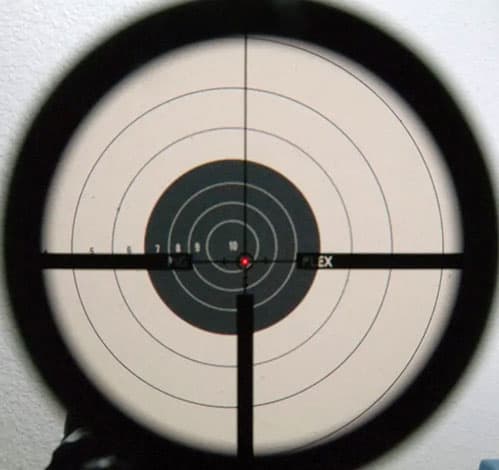
These reticles, unlike the latter, will feature the ability to glow or light up the reticle. This can increase the price by quite a bit, depending on the brand and the quality, but it’s much worth it if you need it. With an illuminated reticle, you’ll be able to switch it on for dark shooting as well as against a background that blends with your reticle. This way, you can always count on being able to see your reticle no matter what the situation is.
Cross Hairs
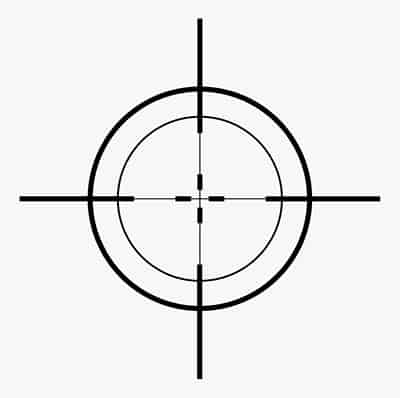
This is probably the style that you are going to be the most familiar with. A cross hair reticle features two lines that intersect at the middle to form the aiming point. They can range from the basic two lines, to crosshairs with ranging or hold over markings, or even more complex measurements than that. They are very easy to use and understand, and will give you a great, simple way to guarantee an accurate shot. Many other reticle styles are actually based off of the basic cross hair design.
Duplex Reticle
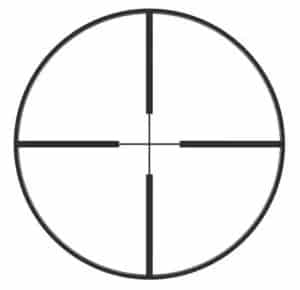
The duplex is pretty much just an upgraded version of the cross hairs. It features thicker lines that start to come to the middle aiming point, which then thin into the middle where they meet. This allows you to make finer adjustments and more precise shots as opposed to just the pure thick cross hairs. Your eye will be immediately drawn to the smaller center, giving you rapid target acquisition as well as an ease of aiming. It also improves the ability to aim at moving targets and is versatile for most types of shooting.
Red Dot Reticle
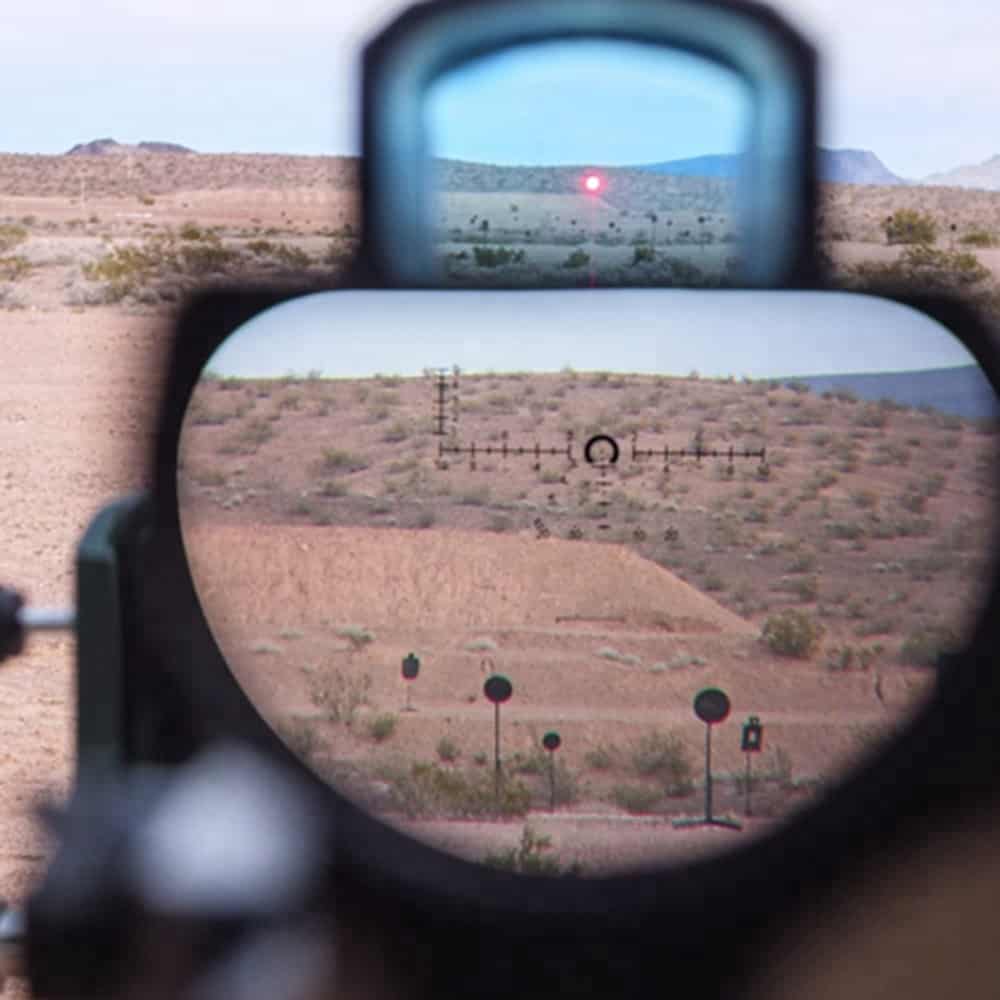
The red dot reticle is exactly what it sounds like: just a red dot that serves as the aiming point. A red dot is typically just a laser contraption that uses reflections to create the illusion that the dot is on the target. Red dots come in many different sizes, smaller being more precise, and bigger being easier and quicker to aim and use. They are very versatile and are great for all types of shooting. Typically, the dots are either green or red. They can also be combined with other reticle types like cross hairs or a duplex reticle to improve the chance of you landing an accurate shot.
Mil Dot Reticle
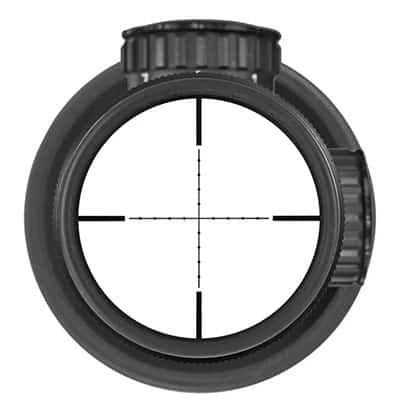
The mil dot reticle is essentially just a version of the duplex reticle, but instead made specifically for long distance shooting. Rather than the basic duplex or cross hairs, the inner lines feature dots that estimate elevation and windage holdover. These dots are great for competition shooters and long range, but will take quite a bit of practice to learn how to use it. It’s a bit complicated and requires knowledge on how the mil measuring system works prior to use.
BDC Reticle
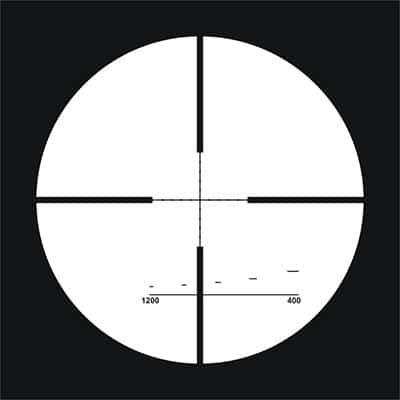
The BDC reticle is a bullet drop compensation reticle. This type of reticle features a type of crosshairs that has markings along the bottom half of the lines, which allows you to estimate the bullet drop of a particular weapon or caliber. BDC reticles can be an amazing tool, but unless you have a ballistics chart, can require some complex calculations in order to properly take advantage of it.
You’ll have to know your caliber, exactly how far your target is, and where you want to land your shot in order to make this reticle work for you. But once you master the operation of the tool, it can be insanely accurate.
German Reticle
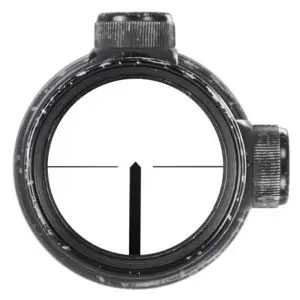
The German reticle features two lines on either side that don’t quite meet up, and then a thicker post that rises from the bottom of the scope to meet in the middle. It’s a type of crosshairs. The bottom post features a sharp point that allows the shooter to use that as a precise aiming point with speed and ease. There’s no top line, but this optic can still be accurate and efficient if you know how to use it correctly.
Christmas Tree Reticle
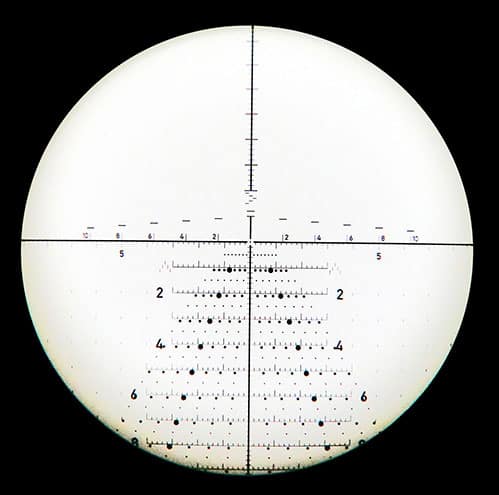
The Christmas Tree reticle is a serious reticle that’s typically used only in tactical applications or military situations. This style of cross hairs features many horizontal lines that extend below the center to allow the shooter to estimate distance, bullet drop, among other things. The lines also become wider as they extend towards the bottom, allowing you to compensate for the pull of the wind that might be present at your time of shooting.
Understanding Reticle Types for Different Shooting Scenarios
Hunting Reticle
Hunting reticles are designed for quick target acquisition and accuracy in varying environments. They often have a simple crosshair design or a duplex reticle, which means thicker outer lines tapering to a thinner center. These reticles are great for fast-moving targets, like animals, as they allow you to quickly line up your shot. They work well in daylight conditions and are easy to use, making them ideal for hunting in open fields.
Long-Range Shooting Reticle
For shooting at long distances, you need a reticle that helps you compensate for bullet drop and wind drift. The Mil Dot reticle is a popular choice for long-range shooting. It features small dots along the crosshairs that allow you to estimate distance and make precise adjustments for bullet drop and windage. This reticle requires some practice to use effectively, but it’s excellent for competitive shooting or hitting targets at great distances.
Target Shooting Reticle
Target shooting demands precision and consistency. Reticles with finer crosshairs, like the thin crosshair or illuminated dot reticle, are well-suited for this purpose. These reticles provide a clear and unobstructed view of the target, allowing you to aim accurately and improve your shooting skills over time. They work well in various shooting ranges and can be used in both bright and low-light conditions.
Tactical Applications Reticle
In tactical situations, speed and versatility are crucial. The Red Dot reticle is a favorite for tactical applications. It’s a simple illuminated red dot that helps you quickly acquire your target, even in high-stress situations. The red dot allows for rapid target acquisition and works well in close to mid-range encounters. It’s widely used in military, law enforcement, and self-defense scenarios.
Low-Light Conditions Reticle
Low-light riflescope shooting requires an illuminated reticle. It can come in various styles, like illuminated crosshairs or dot reticles. The illumination helps the reticle stand out against dark backgrounds, making it easier to aim accurately in dim light or during dusk and dawn. If you enjoy hunting or shooting during low-light hours, an illuminated reticle is a valuable feature to consider.
Reticle Adjustment and Calibration
Step 1: Mounting the Scope
Before you start adjusting the reticle, make sure your scope is properly mounted and secured on your rifle. A stable and precise mounting is essential for accurate shooting.
Step 2: Zeroing the Scope
Zeroing your scope means aligning the point of impact (where the bullet hits the target) with the reticle’s aiming point. To do this, head to a shooting range with a safe shooting area and a suitable target. Start at a short distance, like 25 yards, to make adjustments easier.
Step 3: Reticle Tracking Calibration
After zeroing your scope at a specific distance, it’s crucial to ensure the reticle maintains accuracy across the entire range of adjustments (e.g., different magnifications or turret clicks). This is known as reticle tracking calibration. Shoot at different distances, such as 100, 200, and 300 yards, while maintaining the zeroed settings. The shots should consistently hit the target near the reticle’s aiming point.
Now, adjust your scope’s magnification and shoot at the same target. The point of impact should shift accordingly while maintaining accuracy. Similarly, if you make adjustments using the windage and elevation turrets, the shots should move as expected, and the reticle remains accurate. If you notice any discrepancies or inconsistencies, re-zero your scope at a specific distance and repeat the process.
Reticle Materials and Construction
Wire Reticles
Traditionally, reticles were made using fine wires or threads, usually made of materials like metal alloys or thin metal wires. These wires were meticulously placed in the scope to form the reticle pattern. Wire reticles can be delicate and susceptible to damage. Rough handling or recoil from shooting can cause the wires to shift, altering the reticle’s alignment. This impact on durability means wire reticles may require more careful handling. They can sometimes create slight distortion in the image seen through the scope. This distortion may be more noticeable at higher magnification levels and can affect image clarity.
Etched Glass Reticles
Modern scopes often use etched glass reticles. In this method, the reticle pattern is laser-etched onto a glass surface within the scope tube. This process allows for more intricate and precise reticle designs. Etched glass reticles are more durable compared to wire reticles. Being etched onto the glass, they are less prone to shifting or misalignment due to recoil or impacts. This durability makes etched glass reticles more suitable for rugged use and harsh environments. They offer excellent image clarity. Since the reticle is etched onto the glass, it doesn’t introduce any additional distortion to the sight picture. This ensures a crisp and clear image, even at high magnifications.
Choosing the Right Scope Reticles, Factors to Consider
Choosing the right scope reticle is crucial for improving your shooting accuracy and overall performance. Here are some additional insights on the factors to consider:
Shooting Discipline
Different shooting disciplines have specific reticle preferences that cater to their unique requirements. If you are a hunter, long-range shooter or tactical shooter, you should consider using reticles that match your shooting style, as discussed earlier.
Target Distance
Consider the typical distances at which you’ll be shooting. For long-range shooting, reticles with holdover marks or bullet drop compensation (BDC) are advantageous. They help you estimate how much your bullet will drop over distance and compensate accordingly. On the other hand, for shorter distances, a simple and uncluttered reticle can be more practical and easier to use.
Lighting Conditions
The lighting conditions in which you shoot play a significant role in reticle choice. If you often find yourself in low-light situations like dawn or dusk, an illuminated reticle can be a game-changer. However, if you primarily shoot in bright daylight, a non-illuminated reticle may be sufficient.
Personal Preference
Your shooting style and preferences matter. Some shooters may favor thinner crosshairs for precise aiming and minimal obstruction of the target. Others might prefer thicker lines for quick target acquisition and ease of use, especially in high-pressure shooting scenarios. Consider what reticle design feels most comfortable and natural for you, as it can impact your shooting performance and overall enjoyment.
Budget
While it’s essential to consider your budget when choosing a reticle, remember that investing in the right features can significantly enhance your shooting experience. Advanced reticles with illuminated options or complex designs may cost more, but they can provide valuable advantages in certain shooting situations.
FAQs
Can I change the reticle in my scope?
Changing the reticle in a scope is not a simple task and is usually not something you can do on your own. Scopes come with fixed reticles that are either wire reticles or etched onto glass. If you want to change the reticle, you’ll likely need to send the scope to the manufacturer for reticle replacement. It can be a costly and time-consuming process. Simply put, it’s almost impossible to find a manufacturer that will change reticles for you because it would cost more. It is easier for the manufacturer to mass produce than to work on changing already-made reticles. Just sell the old one and buy the scope with the reticle you want.
Do illuminated reticles drain the battery quickly?
It will only drain the battery quickly if you use the highest brightness settings or leave it on for too long. The battery life of illuminated reticles varies depending on the type of scope and the brightness settings used. However, modern illuminated reticles are designed to be power-efficient. Most scopes with illuminated reticles have multiple brightness levels, allowing you to adjust the brightness according to your needs. Using a lower brightness setting can help conserve battery life, but it’s still a good idea to carry spare batteries when using an illuminated reticle, especially on extended shooting trips.
Are BDC reticles suitable for long-range shooting?
Yes, BDC (Bullet Drop Compensation) reticles are designed to assist with long-range shooting. They have markings or holdover points that help compensate for bullet drop at different distances. BDC reticles can be effective for hitting targets accurately at varying ranges without making adjustments to the scope’s elevation turret. However, for extremely long-range shots, additional calculations and practice might still be necessary to achieve precise accuracy.
How often should I clean my scope reticles?
You should not clean your scope reticle. Cleaning your scope reticles is almost impossible because the reticles are etched on the internal part of the lens. If the lens surface becomes dirty or dusty, you can gently use compressed air to blow off loose debris.
Can I use the same reticle for different shooting disciplines?
The suitability of a reticle for different shooting disciplines depends on the reticle type and the shooting scenario. Some versatile reticles, like duplex or BDC reticles, can be used for various shooting disciplines. However, specialized reticles, such as mil-dot reticles for long-range shooting, might not be as suitable for close-range or tactical applications. Choosing a reticle that aligns with your primary shooting discipline is recommended for optimal performance.
What is the purpose of a fine crosshair reticle?
A fine crosshair reticle is designed to offer precise aiming. The thin lines create a small aiming point, which allows shooters to make accurate shots, especially at longer distances. Fine crosshair reticles are commonly used in target shooting and precision shooting, where pinpoint accuracy is crucial.
Are mil-dot reticles difficult to learn and use?
Mil-dot reticles can be a bit challenging to learn initially, but with practice, they become very useful for long-range shooting. The mil-dot system helps estimate the range to the target and compensates for bullet drop and wind drift. With experience, shooters can quickly make adjustments for different distances and shooting conditions using the mil-dot reticle.

Mike Hardesty is a published freelance gun writer. He also possesses specialized expertise in rifle scopes With dozens of articles and reviews published in Pew Pew Tactical, Snipercountry.com, and TTAG (The Truth About Guns), Mike is considered a firearms expert. His special area of expertise is handguns.
Mike is a long-time shooter. He has been punching paper targets, taking deer and other game and shooting at competitions since about 1975. Other related pursuits include reloading and bullet casting. He currently reloads for over 10 calibers, both handgun and rifle. His reloads, particularly for 9mm, were in great demand during the height of the ammo shortage among family and friends. He donated hundreds of rounds to informal shooting sessions. He was quoted as saying “I do not sell my reloads but I sure will help my guys shoot ’em for free!”. He has a few cherished firearms that he has inherited or otherwise procured — those are his favorites.
He earned B.S. and M.S. degrees from Indiana State University in 1974-1975.
He’s a firearm experts and is the founder of mhardesty.com.
